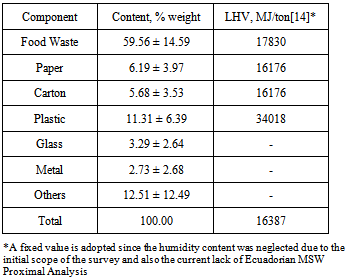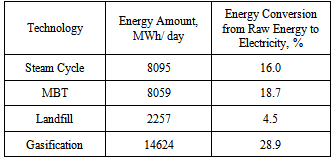-
Paper Information
- Next Paper
- Paper Submission
-
Journal Information
- About This Journal
- Editorial Board
- Current Issue
- Archive
- Author Guidelines
- Contact Us
International Journal of Energy Engineering
p-ISSN: 2163-1891 e-ISSN: 2163-1905
2013; 3(6): 279-286
doi:10.5923/j.ijee.20130306.01
Potential of Waste-to- Energy Implementation in Ecuador
Ricardo A. Narváez C.1, Gabriela Vargas2, Fabián Espinoza3
1National Institute of Energy Efficiency & Renewable Energy (Instituto Nacional de Eficiencia Energética y Energías Renovables, INER), Quito, EC170102, Ecuador
2Faculty of Chemical Engineering, Universidad Central del Ecuador, Quito, EC170118, Ecuador
3Ministry of Environment of Ecuador (Ministerio del Ambiente de Ecuador, MAE), Quito, Pichincha, EC170112, Ecuador
Correspondence to: Ricardo A. Narváez C., National Institute of Energy Efficiency & Renewable Energy (Instituto Nacional de Eficiencia Energética y Energías Renovables, INER), Quito, EC170102, Ecuador.
| Email: |  |
Copyright © 2012 Scientific & Academic Publishing. All Rights Reserved.
The purpose of the current survey was to analyze the potential for energy generation using municipal solid waste (MSW) in Ecuador as a biomass source, considering the current policies in terms of MSW management and related environmental protection. The MSW situation analysis was based on the regulations dictated by the local Constitution and the Environmental Authority. It is established that the local governments (GADs) are responsible for the MSW management inside their jurisdictions and also the Environmental Authority is responsible to verify the mandatory integral MSW management plans accomplishment through the National Solid Waste Integral Management Program (PNGIDS). The energy analysis focused on the current generation rate and MSW composition Generic figures of heating value obtained for each one of the components were used in the calculations. Results show that Ecuador has a raw waste- to- energy potential of 18 467 MWh/ year. Since the energy generation depends on the chosen technology, it was estimated that the amount of available MSW has the potential to produce 2 955 MWh of electricity/ year through steam cycle, 5 338 MWh of electricity/ year through gasification plus internal combustion engine (ICE), 2 942 MWh of electricity/ year through anaerobic digestion plus ICE and 824 MWh of electricity/ year through landfill gas collection plus ICE.
Keywords: Municipal Solid Waste, Biomass, Bioenergy, Burning, Gasification, Mechanical & Biological Treatment, MSW Composition, Developing Countries
Cite this paper: Ricardo A. Narváez C., Gabriela Vargas, Fabián Espinoza, Potential of Waste-to- Energy Implementation in Ecuador, International Journal of Energy Engineering, Vol. 3 No. 6, 2013, pp. 279-286. doi: 10.5923/j.ijee.20130306.01.
Article Outline
1. Introduction
- The use of municipal solid waste (MSW) as a source of biomass for energy production appears as a suitable option to solve the final disposal problem found in developing countries as Ecuador is. In this particular case, the integral waste management at large scale is relatively new and the current authorities have shown interest on this topic. It is also important to mention the global trend shows the energy amount obtained from waste materials is projected to duplicate by 2030[1].Furthermore, it can be mentioned that waste- to- energy implementation is recognized as a remarkable energy supply considering the relatively high amount of energy it can deliver and also as an appropriate way to mitigate global warming.Current policy in Ecuador promotes the conservation of the environment, among other actions in order to achieve the “Sumak Kawsay” which is understood as a general wellbeing state spread along its population.The Ecuadorian Constitution[2] recognizes living in a healthy, ecologically balanced and pollution- free habitat as a right that has to be guaranteed by public authorities at all levels.The Ecuadorian law establishes the jurisdiction of MSW is in charge of Autonomous Decentralized Governments (GADs)[3], which are self-directing to decide the most convenient manner to dispose or obtain benefits from their own residues as long as they implement an environmentally appropriate solution instead of the current disposal yards that remains as the most common solution along the country.In spite of the GAD's being independent on this topic, the Environmental Authority regulates the MSW management through the National Program for the Integral Waste Management (PNGIDS). The PNGIDS acts as the local regulating organism for the waste disposal facilities under the GAD management and offers technical assistance. PNGIDS acts in agreement to the regulation expedited by the Environmental Authority[4] for waste disposal issues. Regardless of not being allowed to interfere with the GAD waste management, it has the authority to regulate their activity through economical penalties in case of any breach.The Environmental Authority directions for MSW are in agreement with the energy generation attached to a waste management program, so in response, the authors analyse the potential of waste- to- energy projects implementation in Ecuador considering the MSW as an energy source which is suitable to apply for the local incentives granted to the non- conventional renewable energy generation[5] and also to any other kind related to global warming mitigation.The purpose of the authors is to explore the potential of MSW as a source of energy through the Ecuadorian case analysis.The current work developed an estimation of the amount of energy that can be obtained from solid residues in Ecuador, based on PNGIDS official data about MSW generation, MSW composition reported from the same official source, single components thermal properties from current references, and reported referential figures about efficiencies and performance of different waste- to- energy technologies.During the current work development, it was considered the waste composition is affected by particular regions factors; hence each municipality was treated in a particular basis regarding demographical data and MSW official figures. Influencing factors such as economics, social and geographical situations which can be analyzed separately in future works. Thermal properties figures were estimated for each region in an individual basis in order to maintain consistency with the consideration about singularity previously established.The current work includes a geographical and demographical approach in order to validate the necessity of the particular treatment of each municipality as the minimum unit taken for the current analysis. It is necessary to mention the authors neglect the seasonal effect on the MSW composition in order to develop this issue with a higher detail in further surveys. In addition, the amount of MSW already disposed was not considered either since the interest on the energy generation is recent and the current facilities such as local landfills were not designed with this purpose in most of the cases when they were built, according to the PNGIDS.All the scenarios to be analyzed consider a complete implementation of waste- to- energy generation facilities along the study case per municipality, which require of the total amount of their MSW daily generation, neglecting the potential development of uses of final disposing methods.
2. Current Issues Related to Energy and MSW in Ecuador
2.1. Social Situation
- The statistical information registered in[6] shows Ecuador had 14 483 499 inhabitants in (year) which are concentrated on four big urban centres (Quito, Guayaquil, Cuenca and Santo Domingo). The average population growth rate is 1.95%. These cities are the main generators of MSW; however there are two special cases because of their particular waste management situation: Cuenca and Loja. Cuenca is the first city in Ecuador with a successful system of electric energy generation from landfill gas currently operating (1 MW of installed capacity[7]).Loja (214 855 inhabitants[6]) which has developed a sustainable waste management system. This particular case combines classification at source, compost production, landfill and recycling carried by small agents from the local community which affects the composition of the MSW fraction available for electricity generation. All the maps were elaborated by using SAGA GIS®.The MSW generation data show the current production is 10 614 ton/ day. Figure 2 shows the jurisdictions with relatively high amount of inhabitants are the main contributors to the MSW production in most of the cases and Figure 3 shows the main municipalities that can be found along the country in terms of population.
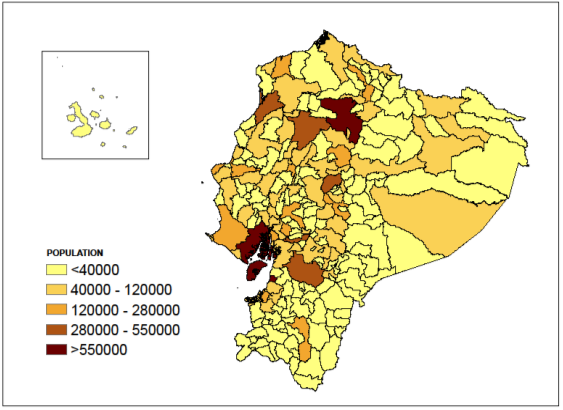 | Figure 1. Population Distribution in Ecuador |
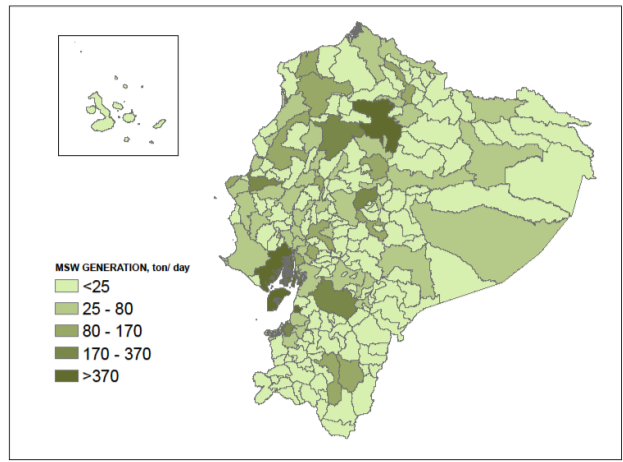 | Figure 2. Population Settlements in Ecuador |
 | Figure 3. Main Municipalities |
2.2. Relationship between Social Scenario and Economic Situation
- Regarding the local economic and social indexes, it is important to mention the National Gini Coefficient was 0.44 in December 2011[6] with a notorious descending trend which means average inequity in Ecuador is being reduced. Since a low value for the Gini Coefficient can be understood as a relatively similar life quality along the country, this figure is used in order to asseverate the MSW composition maintains a similarity useful for waste-to-energy estimations inside this study case as a primary estimation. It is also important to mention MSW composition is closely related to the population habits and its similarity despite the climate regions found along the country.The analysis developed included a primary projection analysis related to the population growth rate however this did not contemplate any MSW reduction policy except for the documented recycling initiatives.The relationship of MSW generation and the population located on each administrative division is presented in the Figure 4.
 | Figure 4. Correlation between MSW Generation and Population Size |
 | Figure 5. Correlation between MSW Generation and Population Size |
 | Figure 6. Correlation between MSW Generation per Inhabitant and Population Size |
2.3. Regional & Local Electricity Sector Situation
- According to[8], Latin America and the Caribbean Region (LAC) have a total installed capacity of 316 745.4 MW which detail is shown in Figure 7.Figures about electricity consumption show a total consumption of 22 007.39 TWh/ yr and 37.3 kWh/ (yr * inhabitant) in LAC.
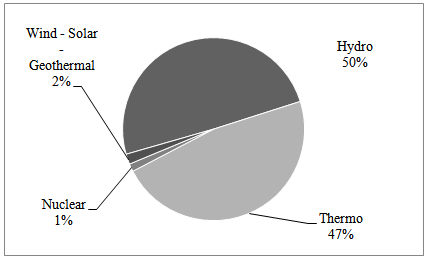 | Figure 7. Electrical Energy Matrix by the Energy Source in Latin America & the Caribbean Region |
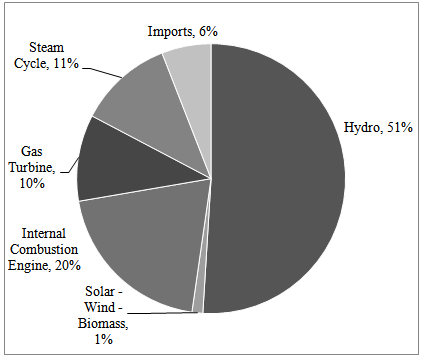 | Figure 8. Electrical Energy Matrix by the Energy Source in Ecuador |
3. MSW Situation in Ecuador
- Considering the Ecuadorian population is mainly centralized in large urban centres, the four main cities (GADs) according to the number of inhabitants were mentioned owing to embrace at least the 70% of the population as a representative sample.Besides this description, the authors considered to include a comment about the local environmental law in order to bring to this context the possibility of a potential waste- to- energy development.
3.1. City of Quito
- The city of Quito regulates the MSW final disposal through the ordinance 213[10]. The regulation forbids abandoning any kind of waste in dump yards explicitly however it mentions the landfill disposal as the appropriate waste management option. This municipal rule also mentions the possibility of producing energy from the MSW as long as the environmental control requirements established by the municipality about waste management (disposal methods and environmental quality standards and control) are implemented together with the project.The waste management is currently in charge of a public enterprise created with this purpose (EMGIRS) which jurisdiction is exclusive for the Municipality of Quito.
3.2. City of Guayaquil
- The Municipality of Guayaquil also has established its own regulation to regulate the MSW management[11]. Even though there is no recommendation for a specific final disposal technology, it forbids the incineration close to urban areas. The local regulation does an especial focus on appropriate recommendations for temporary storage considering that the local weather allows a relatively quick MSW decomposition.The MSW management has been assigned to a private agent which operations follow the regulations previously mentioned.
3.3 City of Cuenca
- As it was mentioned previously, Cuenca is the first city in Ecuador that installed a successful waste- to- energy system based on landfill gas collection. Its local norms establish the GAD is responsible of the MSW landfill disposal, nevertheless recycling and other MSW transformation initiatives will be regulated and enhanced by the local Government[12]. The local municipal enterprise on charge of cleanliness (EMAC) is the current manager responsible of this matter.
3.4. City of Santo Domingo de los Tsáchilas
- This GAD has not established a particular MSW regulation therefore the concerning actions inside its jurisdiction are referred to the local environmental law[13]. The use of dump yards is still applicable inside this jurisdiction; however the GAD of Santo Domingo is currently being assisted by the Environmental Authority in order to install a MSW disposal facility which technology is currently being analyzed.
3.5. Environmental Legislation
- The Ecuadorian environmental law (TULAS) makes a reference to MSW in the annex referred to solid waste in general[13]. Even though the document presents an extensive treatment about solid waste and landfill facilities and environmental control requirements, there are no references to waste- to- energy alternatives.The TULAS also specifies that the GAD has complete jurisdiction over the MSW management. The waste- to- energy projects development is enhanced by a special feed-in tariff since municipal waste is considered as a renewable energy source by the Ecuadorian regulations[5]. The National Electricity Council (CONELEC) has established a special feed-in tariff for renewable energy owing to diversify the energy matrix and also to look with favour on the environment and the population in general.
|
3.6. MSW Composition
- This part of the analysis was based on the information from the PNGIDS[23] regarding the MSW composition obtained for each one of the local governments. The average composition was calculated in order to deliver a group of figures to be combined with the current generation data. The figures mentioned before were used to develop the raw waste to energy capacity available in the study case.The table below shows the average global composition of MSW in Ecuador. An estimation of the lower heating value (LHV) is also included.
4. Energy Potential
4.1. Baseline & Calculation Scope
- The current survey took the daily energy that could be obtained with the data available about generation and energy content (LHV) showed in this document. The raw amount of energy obtained was used as baseline in order to estimate the efficiency of each one of the considered technologies.The raw amount of energy is 50 594 MWh/ day since the national MSW generation is 11 114 ton/ day and the LHV is the figure presented in Table 2.
|
 | (1) |
4.2. Combustion in a Steam (Rankine Cycle) Power Plant
- In its most basic configuration, this technology requires a fired water boiler which is the piece of equipment to convert the MSW into heat, a steam turbine, a condensing heat exchanger together with a cooling tower and a pump.In a Rankine Cycle, an important amount of energy has to be dissipated to the environment in order to reinject the thermal fluid (water) to the cycle; therefore efficiency of the whole process is relatively low. Efficiency figures considered are 80% for the fired heated steam generator and 75% for the steam turbine. The working fluid condensing cycle is designed to dissipate three times the energy produced by the steam turbine. It is necessary since it is required to condensate the working fluid in order to reinject it to the process. In this particular case, the energy required for pumping is neglected. The referential value of 16.0% is mentioned in the Table 3.
|
4.3. MBT
- This stage requires the implementation of a biodigester in order to convert the volatile organic matter contained in the MSW. The conversion is possible due to the microbiological activity in the absence of oxygen and the estimation considered only the part named food waste due to its decomposition suitability. Since the bacteria used for anaerobic digestion are able to consume the organic volatile components and the biogas generated depends directly on this figure, a common value of this group of substances was taken (0,661 m3 biogas/ kg of volatile solids,[15]). The possibility of using biogas as a fuel is a consequence of its methane content ([15],[16]); therefore an appropriate value of its composition (70% vol.) and energy content was selected for this study.Regarding the ICE technology is well- known and widely spread, this is chosen for this assay. A common value of conversion rate was chosen for the current calculations. An efficiency value of 35% was considered for the calculation. This was made considering reported values of standard fuel consumption (SFC) from[17].
4.4. Landfill Gas Collection
- This technology is similar to the MBT case; nevertheless the collection of gas is not as efficient as the previous case (MBT) due to the leakage of gas through the landfill terrain. The energy conversion rate was estimated with similar figures; however the gas capturing was assigned with a reported percentage of the total production (35%)[18] and the methane content was corrected because of the biochemical reactions conditions change (56% vol.)[15].
4.5. Gasification
- This is a commonly used technology regarding the thermochemical conversion for waste- to- energy implementation. It is based on the incomplete combustion of MSW owing to the generation of syngas, which is characterized by the content of hydrogen and carbon monoxide as the main contributors to the gas energy content. The core of the chemical process is the gasifier which has a relatively higher conversion rate in comparison with microbiological based technologies[19] and also allows using other types of organic waste besides food waste which increases the MSW energy content in comparison with MBT.As it was done on the previous cases, the energy conversion equipment is an ICE with the possibility of feeding energy to the national grid (SNI)[20]. Energy conversion on this case considers the gasification process has 83% overall efficiency. This figure is obtained by assuming the reaction conversion reaches 90% of the total biomass stream, and heat loss is equivalent to 7%. Those variables are suitable to be supposed since they depend on the gasification equipment size and isolation besides the feedstock composition and operating temperature. A reported value was adopted for this case[21]. Moreover, the conversion is affected by the engine efficiency (35% overall according to[22]), therefore, the efficiency value adopted for the complete process is 28.9%.
6. Results
- The raw potential energy generation located according to the political division is presented in Figure 9.
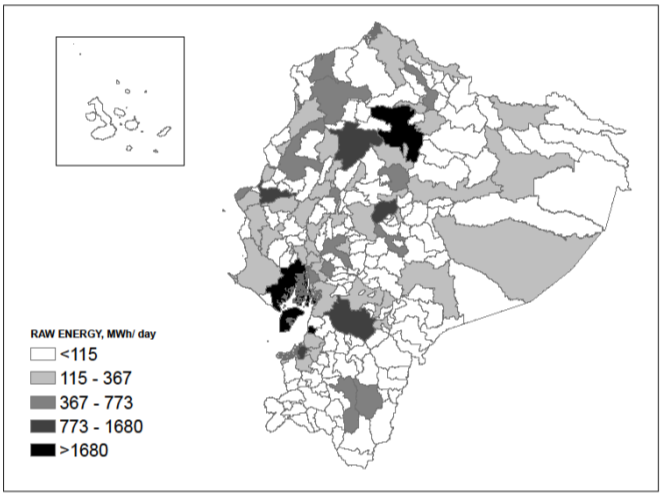 | Figure 9. Raw Energy Generation Potential by GAD |
7. Final Considerations
- According to the obtained results, the most promising scenario shows it is possible to generate 14624 MWh/ day. Concerning the facts included in this document about the electrical energy generated in Ecuador, it is recognized that the amount of energy that can be produced from the MSW is remarkable if it is related with the current generation capacity.The gasification technology appears as the one with the greatest electricity generation potential in an global scale, however it is necessary to develop more specific surveys for each location that consider specific characteristics of the MSW in each municipality instead of estimation based on overall MSW properties values. Since the estimations are based on the results of several surveys, it is required to clarify a most accurate estimation demands to research the local MSW as energy feedstock.MBT and Steam cycle scenarios show similar figures in terms of energy generation (8059 MWh/ day against 8095 MWh/ day). Considering this only parameter presents comparable figures, it indicates it is necessary to develop more comparison indicators for all the scenarios considered.Landfilling presents the lowest generating potential of all studied scenarios (2257 MWh/ day), therefore it is concluded this option should not be considered for future implementation if the energy prospective is the only parameter taken into consideration. It is important to mention the energy conversion figures obtained by this survey have a degree of uncertainty due to the current lack of local MSW composition data. The estimation was developed from a global composition initially assumed, and also reported data about waste- to- energy facilities operation which should be improved in future analyses in order to achieve a higher certainty. A more accurate estimation requires a more precise MSW characterization followed by energy conversion surveys through simulations and pilot scale facilities development.Regarding the MSW geographical distribution, it has to be pointed the energy potential remains concentrated in the GADs that have a relatively large number of inhabitants which is supported in the correlation index that was obtained (R2 = 0.9167). On the other hand, MSW generation per inhabitant shows a low correlation with the population size; consequently it is reasonable to analyze each case in a singular base as it was done (R2 = 0.0677). On the topic of the geographical approach that was developed, results brings to sight there is an important group of political administrations that does not have an important amount of MSW by themselves. This fact reveals there is the opportunity for developing related research works focused on the specific GAD association proposals taking into consideration economical facilities sizing considerations. This affirmation is proposed regarding the current Ecuadorian law encourages the union among GADs with the purpose of developing situations that enhance their MSW management plans[23].
ACKNOWLEDGEMENTS
- The authors thank to the Ministry of Electricity & Renewable Energy of Ecuador for their assistance during the data acquisition for this survey and also to the National Institute of Energy Efficiency & Renewable Energy. Authors express an additional acknowledge to PNGIDS for their help during the data acquisition.
 Abstract
Abstract Reference
Reference Full-Text PDF
Full-Text PDF Full-text HTML
Full-text HTML
